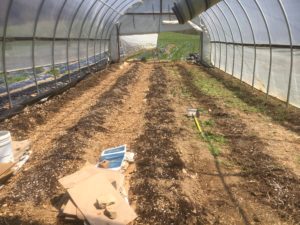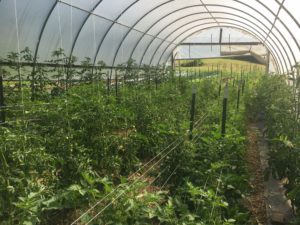Lessons from the Crawdad
I have been spending many hours a week in the Crawdad hoop-house at the Harvest Table,
so named for the crustaceans that make their homes in the soil. This year the hoop-house is planted in tomatoes; long-vining indeterminates of numerous varieties, as well as our precious Principe Borges plants that will provide the fruit for our gallons of sun-dried tomatoes. Becoming the Guardian of the Crawdad was something of an accident, but the more I took care of the plants, the more I wanted to continue to be there for them every step of the way.

Now it’s the highlight of my week to be down there pruning, trellising, and carefully inspecting all the growing tomato plants. I tend to fret over them like a parent, lovingly squinting at every leaf for signs of pests or disease, and from this close observation I can glean a deeper understanding of their habits and behaviors, responses to their environment, and overall expression of their quality of life. This type of understanding can only be learned from firsthand experience, so I am thankful to be able to have the time to spend with them.
I have been spending increasingly more of my time at the Harvest Table working alone. Holding multiple jobs has meant that I don’t always get to work regular hours at the farm, and spend evenings and weekends digging and weeding instead. This has granted me with the unique opportunity of taking on my own projects while still under the wing of my mentor, and has allowed me to build my knowledge and skills more than if I was either always or never on my own. The Crawdad tomatoes tacitly becoming my responsibility is a step in my progression toward becoming an successful farmer.

The farms I had worked on previously had large rotating crews, so it feels special to be able to actually see the direct results of my own actions week by week.
It’s nerve-wracking and empowering at the same time. For better or for worse, when I make a decision in the Crawdad, I will see the long-term impact of that decision, and that is an invaluable asset to my education.
On the other hand, however, if I were truly alone in the Crawdad—lacking the guidance to get things started the right way, and having to turn to the internet or call the extension agent every time something seemed amiss—I would probably be in over my head. Working this way allows me to practice farming independently while still knowing that as much support as I may need is available at all times. When I don’t recognize an insect or need help figuring out a trellising move, I can go to Jason and we can work out the answer together.

From preparing the Crawdad beds in my first-ever tilling passes on a tractor, to hand-forking in the mineral amendments, planting, watering, pounding T posts and looping endless knots around them, climbing the ladder to hang vertical trellises, and carefully keeping the plants corralled in their assigned locations week after week, a lot of work has gone into the tomatoes already. The hard green fruits appearing lately have brought reassurance, and soon the bushels and bushels of tomatoes will make it all worthwhile. The plants are well on their way to reaching above my head, and my confidence is growing up right alongside them.
By Mandy Hart, 2018 FARM Intern
Harvest Table Farm
Contact The Project Manager
